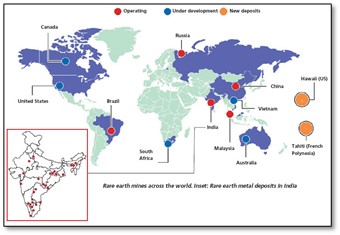Thursday, 17th June 2021
Project 75-I
In News
Ministry of Defence (MoD) has approved the long-delayed ‘Project 75-I’ to build six submarines in the country.

About the News
- Context: The Defence Acquisition Council (DAC), chaired by Defence Minister, formally cleared India’s ambitious but long delayed Rs.43,000-crore project to build indigenously six new generation stealth submarines with foreign collaboration under the strategic partnership (SP) model.
- Strategic Partners: Two Indian strategic partners with submarine-building experience have been picked. The strategic partner must ensure a minimum of 45 percent indigenisation in five of the subs and at least 60 percent indigenous content in the sixth one.
- Features of the Submarine: These six conventional submarines will be equipped with the state-of-the-art, air independent propulsion (AIP) systems which will help them stay underwater for longer periods of time.
Significance of the project
- India does not have a friendly neighbourhood and considering most of its territories border the Indian Ocean and the Arabian Sea and Pakistan and China expanding their naval fleets It is imperative for the country to augment its underwater combat arm urgently as the navy cannot afford to drift anymore.
- The Indian Navy, which currently has in its inventory 15 conventional submarines and two nuclear submarines, is looking to acquire a total of 24 new submarines, including six nuclear attack submarines.
- China’s major expansion plans to build a Blue Water Navy to project power beyond its traditional areas. According to some estimates, its submarine fleet comprises as many as 66 craft, both conventional and nuclear.
What is Project 75-I?
- Code named Project-75 (I), the programme is aimed at enhancing India’s capability to progressively build indigenous capabilities in the private sector to design, develop and manufacture complex weapon systems for the future needs of the Armed Forces.
- The Project-75 (I) programme has been hanging fire for over two decades. While the project itself was originally cleared by the Cabinet Committee on Security (CCS) in 1999, Acceptance of Necessity was granted for the project in 2007. The decision of the DAC, India’s apex procurement body, should now act as a catalyst in what is still a long process.
Trusted telecom portal
In News
The government has launched a 'trusted telecom' portal as a part of the national security directive in the telecommunications sector.
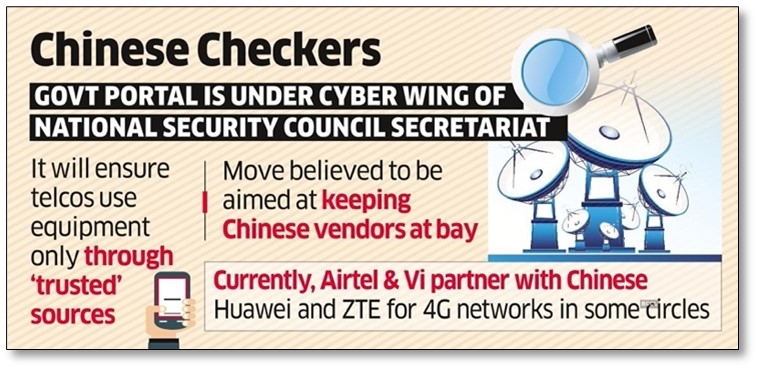
About the News
- With effect from 15th June 2021 the Telecom Service Providers (TSPs) are mandatorily required to connection their networks only those new devices which are designated as ‘Trusted Products’ from ‘Trusted Sources’.
- The move signals the coming into effect of the National Security Directive on Telecommunication Sector (NSDTS).
- The Trusted Telecom portal was developed and implemented by Centre for Development of Telematics (CDoT), is an Indian Government owned telecommunications technology development centre.
- The present Directive does not envisage mandatory replacement of the existing equipment already inducted in the networks of the TSPs. The Directive will also not affect ongoing Annual Maintenance Contracts (AMC) or updates to existing equipment already inducted in the network as on date of effect of the Directive. Hence no disruption to the existing networks will be created due to this Directive.
- The National Cyber Security Coordinator (NCSC) is the Designated Authority (DA) for the determination of inclusion of a vendor as a Trusted Source, of a Telecom product as a Trusted Product and the methodology for the said inclusion.
What are Trusted Products?
- Trusted Products are products whose critical components and the products themselves are sourced from Trusted Sources. The TSPs will be provided access to log into the Trusted Telecom Portal and indicate the telecom products and the vendor from whom they intend to procure the products.
- The National Security Committee on telecom will also take measures to increase use of equipment from such 'Indian Trusted Sources' in domestic telecom networks.
Significance of the move
- The development has come following the government's efforts to ensure security of telecom networks, especially with fifth generation (5G) service on the anvil. The initiative is widely believed to discourage the use of China-made gear in the country's core networks.
- Reliance Jio, for its mega fourth generation or 4G service foray has deployed gear from Korean Samsung Networks while Bharti Airtel and Vodafone Idea continue to partner with Chinese Huawei and ZTE.
- Through this initiative, the government aims to bring enhanced supervision and facilitate effective control by telcos and designated authority over nationwide telecom networks.
Demand for recognition of Tulu language
In News: Various organizations have initiated a Twitter campaign demanding official language status to Tulu in Karnataka and Kerala.
About Tulu Language
- Tulu is a southern Dravidian language that is spoken by 1.85 million people in Dakshina Kannada (48.6% population- 2011 Census), Udupi (31.4%) in Karnataka and Kerala's Kasargod district (16.2%) forming a cultural region often called Tulu Nadu.
- According to the 2011 Census, it is one of the best known non-literary (i.e., not consistently or widely used for literary purposes) Dravidian language, despite having fewer speakers than other languages.
- Tulu has a rich oral literature tradition with folksongs and traditional folk theatre yakshagana because of which scholars suggest it is among the earliest Dravidian languages with a history of 2000 years.
Present status of Tulu and the Demand for its Official Status
- Despite Tulu’s dominance in Tulu Nadu- its position as lingua franca and status as most common mother tongue of the region’s inhabitants - the language has not been issued an official status in its own homeland.
- The Karnataka government introduced Tulu as a language in schools a few years ago.
- Recently requests are being made to the government to give it official language status and include it in the eighth schedule to the Constitution.
What are the advantages of being recognized under the Eighth Schedule?
- Translation of Tulu literary works into other languages.
- Recognition from Sahitya Akademi.
- Members of Parliament (MP) and Members of the Legislative Assembly (MLA) could speak Tulu in Parliament and State Assemblies.
- Special fundsfrom the Central government.
- Teaching of Tulu in primary and high school and taking up Tulu as an option in competitive examinations would be a possibility.
Legal Protection
- Article 29 of the Constitution:It deals with the "Protection of interests of minorities". It states that any section of the citizens residing in any part of India having a distinct language, script, or culture of its own, shall have the right to conserve the same.
- International Conference organized in China by UNESCO announced the adoption of Yuelu Proclamation.
Primary source: https://www.thenewsminute.com/article/mapping-tulu-rich-oral-tradition-deep-roots-karnataka-97512
https://en.unesco.org/news/protection-and-promotion-linguistic-diversity-addressed-unesco
https://indianexpress.com/article/explained/tulu-language-protest-history-7358953/
Deep Ocean Mission
In News
The Union Cabinet has approved the "Deep Ocean Mission".
What is Deep Ocean Mission (DOM)?
- The Deep Ocean Mission is proposed as multi-ministerial multi-disciplinary programme to explore deep ocean for resources and develop deep sea technologies for sustainable use of ocean resources.
- The estimated cost of the Mission will be Rs. 4077 crore for a period of 5 years.
- Ministry of Earth Sciences (MoES) will be the nodal Ministry to implement DOM.
- DOM will be a mission mode project to support the Blue Economy Initiatives of the Government.
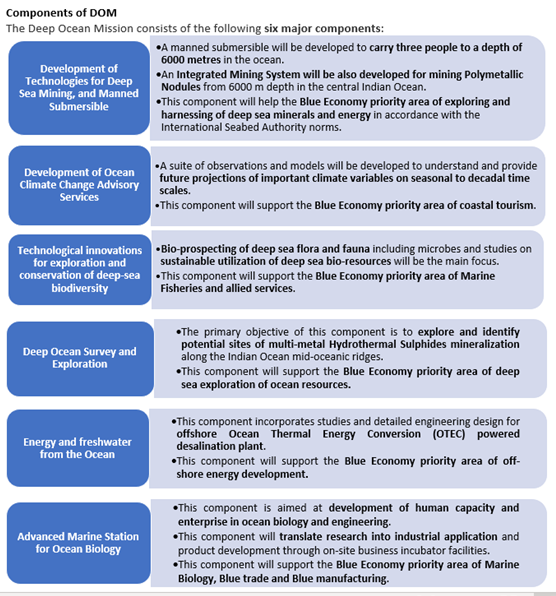
Significance of the DOM
- Indigenization of Technology: The technologies required for deep sea mining have strategic implications and are not commercially available. Hence, attempts will be made to indigenize technologies by collaborating with leading institutes and private industries.
- Employment creation: A research vessel for deep ocean exploration would be built in an Indian shipyard which would create employment opportunities. Also, the capacity development in Marine Biology will provide job opportunities in Indian industries.
- Boost to MSMEs and Start-ups: Design, development and fabrication of specialized equipment, ships and setting up of required infrastructure are expected to spur the growth of the Indian industry, especially the MSME and Start-ups.
- Harnessing Blue Economy: For India, with its three sides surrounded by the oceans and around 30% of the country's population living in coastal areas, ocean is a major economic factor supporting fisheries and aquaculture, tourism, livelihoods and blue trade. Oceans are also storehouse of food, energy, minerals, medicines, modulator of weather and climate and underpin life on Earth.
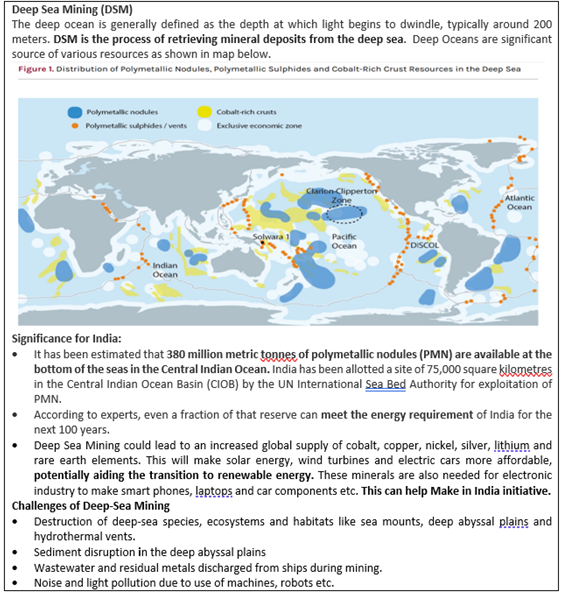
Question: How does the Deep Ocean Mission aim to achieve India’s vision to harness the Blue economy for sustainable growth?
https://pib.gov.in/PressReleasePage.aspx?PRID=1727525
https://pib.gov.in/PressReleasePage.aspx?PRID=1704840
https://moes.gov.in/writereaddata/files/EN_12032021_LS_USQ_No_2803.pdf
This Day in History- World Day to Combat Desertification and Drought
On June 17, 1994, the United Nations General Assembly in December acknowledged this day as World Day to Combat Desertification and Drought, to spread awareness about the cooperation required to combat desertification and drought. This year, the theme of the day is “Restoration. Land. Recovery. We build back better with healthy land”. As per the official United Nations, land degradation negatively impacts the well-being of a minimum of 3.2 billion people. Restoring degraded land brings economic resilience, creates jobs, raises incomes, and increases food security. It helps biodiversity to recover. It locks away the atmospheric carbon warming the Earth, slowing climate change. It can also lessen the impacts of climate change and underpin a green recovery from the COVID-19 pandemic.
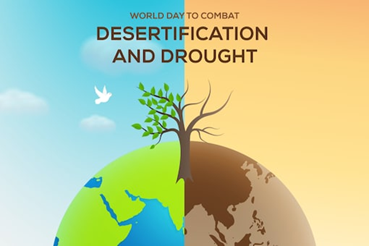
Image of the Day- Spider Webs in Australia
This massive spider webs have blanketed near wetlands in Longford, Victoria, Australia. After heavy rains and floods struck Australia’s southeastern state of Victoria, lakhs of spiders have spun webs stretching across trees, road signs and paddocks, creating huge “gossamer” sheets. In the Gippsland region, days of intense rainfall have caused spiders to climb to higher ground using a survival tactic called “ballooning”, in which the insects throw out silk that latches on to vegetation, allowing them to escape. In one area in Gippsland, a spider web covered more than a kilometre along a road. Because this ballooning silk is lighter than air, it latches on to objects such as tree-tops, tall grass and road signs, allowing the spiders to climb up.
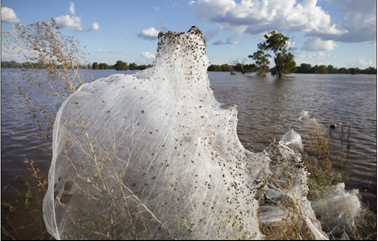
Indo-Thai CORPAT
- Context: India-Thailand Coordinated Patrol (CORPAT) between the Indian Navy and the Royal Thai Navy.
- It is a bi-annual exercise being conducted since 2005 in the Andaman Sea region,close to the Strait of Malacca to develop understanding and interoperability between navies and facilitates institution of measures to suppress unlawful activities like illegal fishing, drug trafficking, piracy, illegal immigration, smuggling, etc.
- As part of India’s vision of SAGAR (Security And Growth for All in the Region), the Indian Navy has been proactively engaging with the Indian Ocean countries for enhanced regional maritime security through bilateral/multilateral exercises, Coordinated Patrols, Joint EEZ Surveillance, and Humanitarian Assistance and Disaster Relief (HADR) operations.
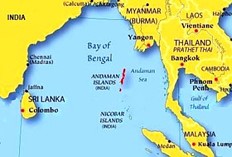
Dedicated Freight Corridor (DFC)
- Context: Recently, the Indian Army conducted a successful trial by moving a military train from New Rewari (Haryana) to New Phulera (Rajasthan), loaded with vehicles and equipment, validating the efficacy of the DFC.
- DFC is a high-speed, high-capacity railway corridor dedicated exclusively for efficient freight transportation system.
- The DFC project involves the construction of six freight corridors traversing the entire country.
- The first two corridors in the implementation stage are the Eastern Freight Corridor and the Western Freight Corridor.
- The other four corridors in planning stage are North-South (Delhi-Tamil Nadu), East-West (West Bengal-Maharashtra), East-South (West Bengal-Andhra Pradesh) and South-South (Tamil Nadu-Goa).

Primary source: https://www.railway-technology.com/projects/dedicatedrailfreight/
Picture source: https://www.slideshare.net/SameerDhurat/dedicated-freight-corridor-85589525
Silver Line Project - Edukemy Current Affairs
- Context: acquiring land for SilverLine rail project in Kerala.
- The project entails building a semi high-speed railway corridor through the state linking its southern end, Thiruvananthapuram with its northern end, Kasaragod.
- The railway line will reduce greenhouse gas emissions, help in expansion of Ro-Ro services, produce employment opportunities, integrate airports and IT corridors and faster development of cities it passes through.
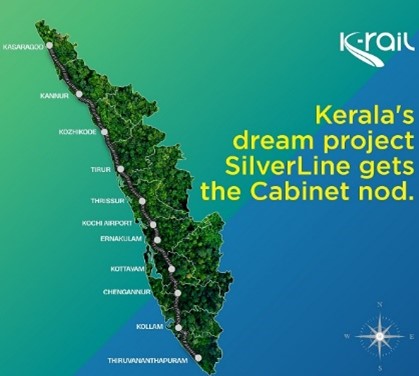
Primary source: https://indianexpress.com/article/explained/kerala-silverline-high-speed-railway-project-7360214/
Picture source: https://themetrorailguy.com/2020/06/11/kerala-govt-approves-530-km-semi-high-speed-silver-line-project/
Jalgaon banana
- Context: GI certified fibre and mineral rich Jalgaon banana has been exported to Dubai.
- The GI certified banana has been sourced from farmers of Tandalwadi village in Maharashtra's Jalgaon district, a cluster identified under the new Agri Export Policy.
- In 2016, Jalgaon Banana got GI certification which was registered with Nisargraja Krishi Vigyan Kendra (KVK) Jalgaon.
- India is the world's leading producer of bananas with a share of around 25% in total output.
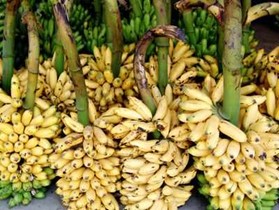
Primary source: https://pib.gov.in/PressReleasePage.aspx?PRID=1727440
Picture source: https://timesofindia.indiatimes.com/city/nashik/jalgaon-banana-farmers-face-unprecedented-financial-crisis/articleshow/75113693.cms
Crafting an Indian exceptionalism in technology policy-HT
Essence: In March this year, just over two months into his term, United States (US) President Joe Biden made two appointments that confirm the change in America’s position on Silicon Valley’s technology behemoths. Against this background of America’s decision to follow a more interventionist line against big tech and Europe’s lead on technology governance through General Data Protection Regulation (GDPR), this article suggests that the Indian approach should be to foster a competitive environment that enhances consumers’ rights, rather than rely on regulatory solutions to do the same.
Why you should read this article?
- Know about the US and EU’s policy against big tech companies and the underlying strategic self-interest.
- Identify the major problems of upcoming digital rights frameworks in India and why India should craft its own exceptionalism that serves its economic interests.
Article Link: https://www.hindustantimes.com/opinion/crafting-an-indian-exceptionalism-in-technology-policy-101623850873047.html
The promise and perils of Artificial Intelligence (AI) partnerships-HT
Essence: The concerns surrounding electoral bonds and the Supreme Court's ruling in a recent hearing on Public Interest Litigation (PIL) by the Association of Democratic Reforms are discussed in this editorial (ADR). Issues of transparency & accountability got further aggravated after amendments were made in 2018, to Foreign Contribution (Regulation) Act (FCRA), 1976.
The ADR PIL challenges electoral bonds as unconstitutional. In effect, electoral bonds give political power to companies, wealthy individual donors, and foreign entities, thus diluting the universal franchise of one voter-one vote. Every vote is not equally valuable if companies can influence policies through hidden donations.
Why you should read this article ?
- To know about the recent opinion of SC on electoral bonds & issues pertaining to their transparency.
- To gain understanding on challenges posed by amendments to FCRA & foreign funding of political parties.
- It is providing insights into the mechanism followed in political funding via electoral bonds & compliances on part of political parties.
Article Link: https://www.thehindu.com/opinion/op-ed/needed-full-disclosure-on-electoral-bonds/article34824570.ece
Meet The Woman Who Has Been Leading Mizo Women’s Push For Legal Reforms For 40 Years!
Background story:
- While growing up, Pi Sangkhumi witnessed various atrocities and injustice meted out to women.
- She realized that it was largely due to the archaic laws, regressive customs, low levels of literacy and awareness among women.
- She made it her life’s mission to make things right.
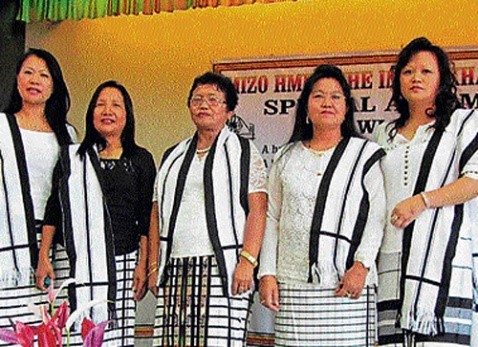
Injustice borne by an ordinary Mizo woman:
- A Mizo woman did not enjoy rights over property, gifts that are given to her at the time of marriage.
- Husband can divorce a Mizo woman any time and throw her out of the house without providing any financial support.
Result of her continuous effort:
- Women’s Movement in Mizoram finally resulted that the State Law Commission agreed to review Mizo Marriage Bill, 2013; The Mizo Inheritance Bill, 2013, and The Mizo Divorce Bill, 2013.
- It will result in changes in the marriage, divorce, and inheritance and succession laws to safeguard the interests of ordinary women.
- Change in laws will bring gender justice, equality and women empowerment
Where can this case study be used:
- Gender justice, Law as a source of bringing reforms in the society
Quote:
- I measure the progress of a community by the degree of progress women have achieved. The condition of women in a nation is the real measure of its progress.: B.R Ambedkar
https://www.deccanherald.com/content/358342/mizos-women-force.html
Share the article
Get Latest Updates on Offers, Event dates, and free Mentorship sessions.

Get in touch with our Expert Academic Counsellors 👋
FAQs
UPSC Daily Current Affairs focuses on learning current events on a daily basis. An aspirant needs to study regular and updated information about current events, news, and relevant topics that are important for UPSC aspirants. It covers national and international affairs, government policies, socio-economic issues, science and technology advancements, and more.
UPSC Daily Current Affairs provides aspirants with a concise and comprehensive overview of the latest happenings and developments across various fields. It helps aspirants stay updated with current affairs and provides them with valuable insights and analysis, which are essential for answering questions in the UPSC examinations. It enhances their knowledge, analytical skills, and ability to connect current affairs with the UPSC syllabus.
UPSC Daily Current Affairs covers a wide range of topics, including politics, economics, science and technology, environment, social issues, governance, international relations, and more. It offers news summaries, in-depth analyses, editorials, opinion pieces, and relevant study materials. It also provides practice questions and quizzes to help aspirants test their understanding of current affairs.
Edukemy's UPSC Daily Current Affairs can be accessed through:
- UPSC Daily Current Affairs can be accessed through Current Affairs tab at the top of the Main Page of Edukemy.
- Edukemy Mobile app: The Daily Current Affairs can also be access through Edukemy Mobile App.
- Social media: Follow Edukemy’s official social media accounts or pages that provide UPSC Daily Current Affairs updates, including Facebook, Twitter, or Telegram channels.


